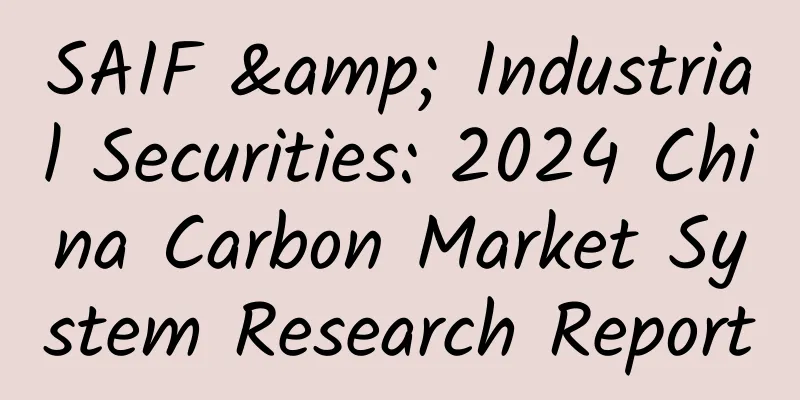SAIF & Industrial Securities: 2024 China Carbon Market System Research Report

|
Carbon emission quotas are one of the basic trading products of the carbon emission trading system. In 2011, the National Development and Reform Commission issued the "Notice on the Pilot Work of Carbon Emission Trading", selecting seven provinces and cities, including Beijing, Tianjin, Shanghai, Chongqing, Hubei, Guangdong and Shenzhen, to carry out the pilot construction of regional carbon emission trading markets. In 2013, the Shenzhen carbon emission trading market was officially launched, becoming the first pilot carbon market in China, and other pilot markets were subsequently launched. At the end of 2016, the Fujian carbon emission trading market was launched. The regional pilot has made innovative attempts in the coverage of the carbon market, the quota allocation method, the compliance and use of offset quotas and other rules, providing valuable experience for further improving the carbon trading mechanism. At the beginning of operation, each pilot market issued corresponding carbon emission trading management measures in the form of local people's congress regulations or local government orders, which stipulated the total quota and allocation and management, trading, monitoring, reporting and verification, incentive and constraint mechanisms. The establishment of laws and regulations is a prerequisite for the effective operation of the carbon emission trading market. After the national carbon market was launched, some pilot markets revised the original management methods or promulgated new methods in order to further implement the dual carbon goals and clarify the management boundaries and connection mechanisms with the national carbon market. In terms of the types of greenhouse gases covered, in the initial stage of the pilot, only Chongqing covered the six gases regulated by the first commitment period of the Kyoto Protocol, namely carbon dioxide, methane, nitrous oxide, hydrofluorocarbons, perfluorocarbons and sulfur hexafluoride, while other pilot markets only covered carbon dioxide. From the perspective of participation thresholds, each pilot market sets its own threshold based on the coverage industries and according to its own development status, mostly based on the annual carbon dioxide equivalent of greenhouse gas emissions. When determining the coverage industries, each pilot market fully considers its own economic structure. For example, Beijing and Shanghai give priority to the inclusion of the service industry, Shanghai later includes the shipping industry, and Guangdong adds papermaking and civil aviation industries. When setting the threshold, different thresholds are set for industrial enterprises and other enterprises, and Shanghai sets different thresholds for enterprises in different industries. Moreover, in the process of development, each pilot market continues to lower the emission threshold and expand the coverage industries to cover more enterprises. The document link will be shared to 199IT Knowledge Planet. Scan the QR code below to view it! |
<<: If you want to use iPhone 7 in winter, you have to be careful with the Home button
>>: Brighter, wider color gamut: What does it mean that the iPhone 7 screen supports DCI-P3?
Recommend
Why has Kuaishou, which is considered "absurd and vulgar" by everyone, become so popular and become the king of short videos?
1. What is Kuaishou ? 1. Basic Introduction Type:...
How can eating a few more bites of such delicious food become an accomplice of disease?
Contributing expert: Li Caihong, Urumqi First Peo...
Invisible attacks, destructive curses…How many unique skills do the “vanguards” of microbial pesticides have?
Produced by: Science Popularization China Author:...
Besides painkillers, what other methods can we use to relieve pain?
Produced by: Science Popularization China Author:...
Apple Pencil vs. Surface Pen: Do you really need a pen for your screen?
Obviously, Apple Pencil is designed for iPad Pro,...
Content Marketing Trends in 2017 (Part 2)
Preface: The 2017 Content Marketing Trends (Part ...
The "most beautiful highway" is newly launched, and visitors can "check in" at the picturesque Three Gorges along the route
Recently, the Ministry of Culture and Tourism, th...
Apple iOS 10 Markup feature details: support for photos and messaging apps
If you have experienced iOS 10, you may have noti...
Those who are supposed to leave will eventually be gone. Party media says Tesla production and sales should be completely stopped
Recently, Driving Vision learned from the party m...
What does an excellent event operation data report look like?
Without data, operations cannot know the effectiv...
AI training AI? Maybe it will become dumber
Written by Ma Xuewei Edited by Paige Preface Curr...
Is the customization cost of Changsha Photo Mini Program high? Changsha photo app customization cost and process
The launch of mini programs has brought convenien...
The most confusing behaviors of strange lizards: bubbles appear on their heads, they shed their scales when encountering enemies...
In the large family of reptiles, lizards have a r...
Why do I see strange patterns when I rub my eyes?
Long working or studying time People's eyes a...









